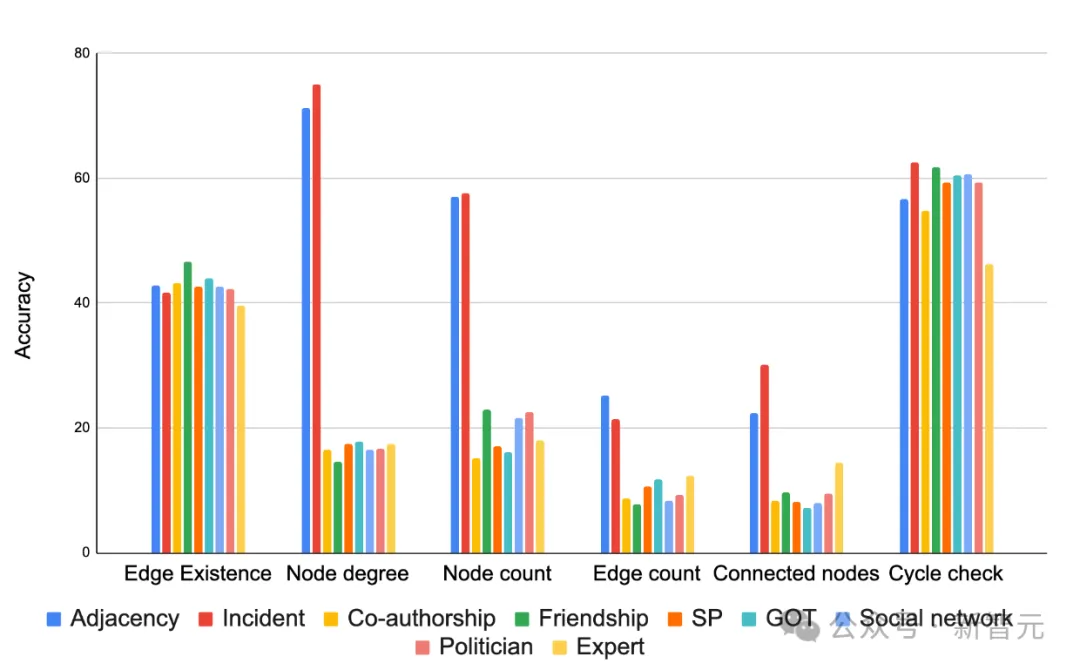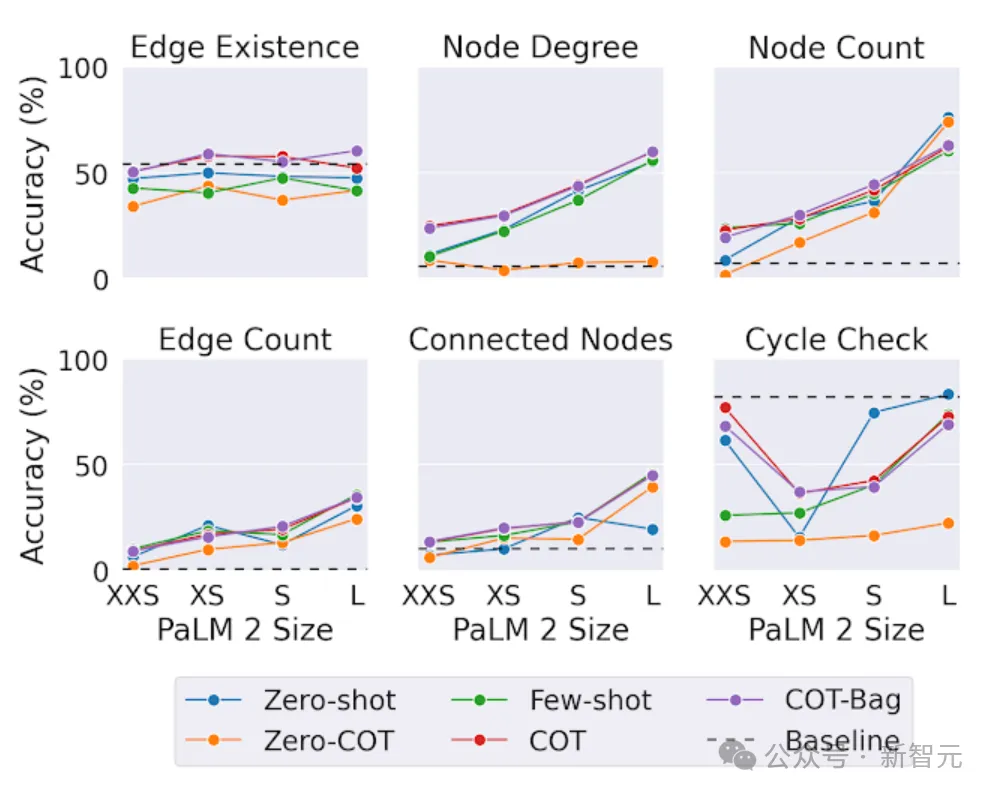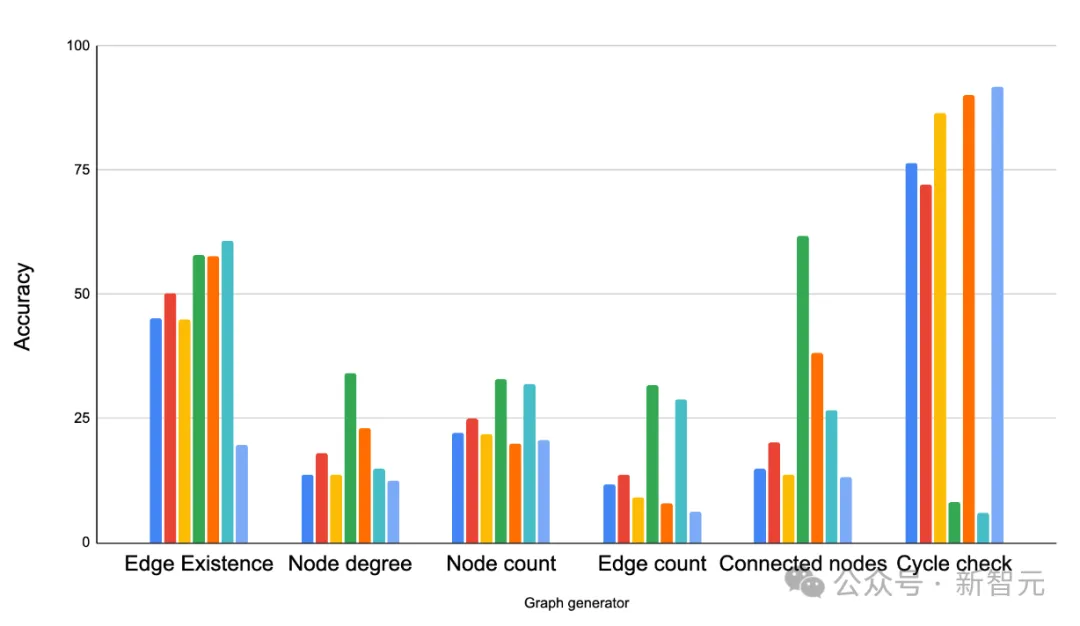 Technology peripherals
Technology peripherals
 AI
AI
 LLM performance is improved by up to 60%! Google ICLR 2024 masterpiece: Let the large language model learn the 'language of graphs'
LLM performance is improved by up to 60%! Google ICLR 2024 masterpiece: Let the large language model learn the 'language of graphs'
LLM performance is improved by up to 60%! Google ICLR 2024 masterpiece: Let the large language model learn the 'language of graphs'
In the field of computer science, a graph structure consists of nodes (representing entities) and edges (representing relationships between entities).
Pictures are everywhere.
The Internet can be regarded as a huge network, and search engines use graphical methods to organize and display information.
LLMs are mainly trained on regular text, so converting graphs into text understandable by LLMs is a challenging task because graph structures are fundamentally different from text.
At ICLR 2024, a team from Google explored how to transform graph data into a form suitable for LLMs to understand.

Paper address: https://openreview.net/pdf?id=IuXR1CCrSi

The process of encoding graphs into text using two different methods and feeding text and questions back to LLM
They also developed a tool called GraphQA A benchmark that explores approaches to solving different graph reasoning problems and shows how to formulate these problems in a way that is conducive to LLM solving graph-related problems.
Using the correct method, LLMs can improve the performance of graphics tasks by up to 60%.
GraphOA: An "exam" for LLMs
First, the Google team designed the GraphQA benchmark, which can be viewed as An exam designed to assess LLM's ability to address specific graphics problems.
GraphOA ensures diversity in breadth and number of connections by using multiple types of graphs to find possible biases in LLMs when processing graphs and make the entire process closer to LLMs situations that may be encountered in practical applications.

A framework for inference on LLMs using GraphIQA
Although the task is simple, such as checking whether an edge existence, counting the number of nodes or edges, etc., but these tasks require LLMs to understand the relationship between nodes and edges, which is crucial for more complex graph reasoning.
At the same time, the team also explored how to convert graphs into text that LLMs can process, such as solving the following two key issues:
Node encoding: How do we represent a single node? Nodes can include simple integers, common names (people, characters), and letters.
Edge Coding: How do we describe the relationships between nodes? Methods can include parentheses, phrases (such as "are friends"), and symbolic representations (such as arrows).
In the end, the researchers systematically combined various node and edge encoding methods to produce functions like those shown in the figure below.

Example of graphical encoding function
How do LLMs perform?
The research team conducted three key experiments on GraphOA:
- Testing the ability of LLMs to handle graphics tasks
- Test the impact of the size of LLMs on performance
- Test the impact of different graph shapes on performance
In Chapter In one experiment, LLMs performed mediocrely. On most basic tasks, LLMs performed no better than random guessing.
But the encoding method significantly affects the results. As shown in the figure below, in most cases, "incident" encoding performs well in most tasks. Choosing the appropriate encoding function can greatly improve the accuracy of the task.

Comparison of various graph encoder functions based on different task accuracy
In the second test, the researchers tested the same on different sized models graphics tasks.
In terms of conclusion, in graphical inference tasks, larger models perform better,
However, interestingly, in In the "edge existence" task (determining whether two nodes in the graph are connected), scale is not as important as in other tasks.
Even the largest LLM cannot always beat simple baseline solutions on the cycle checking problem (determining whether a cycle exists in the graph). This shows that LLMs still have room for improvement on certain graph tasks.

The impact of model capacity on graph reasoning tasks of PaLM 2-XXS, XS, S and L
In the third test, the researchers used GraphOA to generate graphs with different structures for analysis as to whether the graph structure would affect the ability of LMMs to solve problems.

# Examples of graphs generated by GraphQA’s different graph generators. ER, BA, SBM and SFN are Erdős-Rényi, Barabási-Albert, stochastic block model and scale-free network respectively.
The results show that the structure of the graph has a great impact on the performance of LLMs.
For example, in a task asking whether cycles exist, LLMs perform well in closely connected graphs (where cycles are common) but not in path graphs (where cycles are common). never happens).
But at the same time, providing some mixed samples helps LLMs adapt. For example, in the cycle detection task, the researchers added some examples that contain cycles and some that do not contain cycles in the prompts as less Examples of sample learning improve the performance of LLMs in this way.

Compare different graph generators on different graph tasks. The main observation is that graph structure has a significant impact on the performance of LLM. ER, BA, SBM and SFN refer to Erdős-Rényi, Barabási-Albert, stochastic block model and scale-free network respectively.
This is just the beginning of letting LLMs understand graphs
In the paper, the Google team initially explored how to best represent graphs as text so that LLMs can understand them.
With the help of correct coding techniques, the accuracy of LLMs on graph problems is significantly improved (from about 5% to over 60% improvement).
At the same time, three main influencing factors were also determined, which are the encoding method of converting graphics into text, the task types of different graphics, and the density structure of graphics.
This is just the beginning for LLMs to understand graphs. With the help of the new benchmark GraphQA, we look forward to further research to explore more possibilities of LLMs.
The above is the detailed content of LLM performance is improved by up to 60%! Google ICLR 2024 masterpiece: Let the large language model learn the 'language of graphs'. For more information, please follow other related articles on the PHP Chinese website!

Hot AI Tools

Undresser.AI Undress
AI-powered app for creating realistic nude photos

AI Clothes Remover
Online AI tool for removing clothes from photos.

Undress AI Tool
Undress images for free

Clothoff.io
AI clothes remover

AI Hentai Generator
Generate AI Hentai for free.

Hot Article

Hot Tools

Notepad++7.3.1
Easy-to-use and free code editor

SublimeText3 Chinese version
Chinese version, very easy to use

Zend Studio 13.0.1
Powerful PHP integrated development environment

Dreamweaver CS6
Visual web development tools

SublimeText3 Mac version
God-level code editing software (SublimeText3)

Hot Topics
 Open source! Beyond ZoeDepth! DepthFM: Fast and accurate monocular depth estimation!
Apr 03, 2024 pm 12:04 PM
Open source! Beyond ZoeDepth! DepthFM: Fast and accurate monocular depth estimation!
Apr 03, 2024 pm 12:04 PM
0.What does this article do? We propose DepthFM: a versatile and fast state-of-the-art generative monocular depth estimation model. In addition to traditional depth estimation tasks, DepthFM also demonstrates state-of-the-art capabilities in downstream tasks such as depth inpainting. DepthFM is efficient and can synthesize depth maps within a few inference steps. Let’s read about this work together ~ 1. Paper information title: DepthFM: FastMonocularDepthEstimationwithFlowMatching Author: MingGui, JohannesS.Fischer, UlrichPrestel, PingchuanMa, Dmytr
 The world's most powerful open source MoE model is here, with Chinese capabilities comparable to GPT-4, and the price is only nearly one percent of GPT-4-Turbo
May 07, 2024 pm 04:13 PM
The world's most powerful open source MoE model is here, with Chinese capabilities comparable to GPT-4, and the price is only nearly one percent of GPT-4-Turbo
May 07, 2024 pm 04:13 PM
Imagine an artificial intelligence model that not only has the ability to surpass traditional computing, but also achieves more efficient performance at a lower cost. This is not science fiction, DeepSeek-V2[1], the world’s most powerful open source MoE model is here. DeepSeek-V2 is a powerful mixture of experts (MoE) language model with the characteristics of economical training and efficient inference. It consists of 236B parameters, 21B of which are used to activate each marker. Compared with DeepSeek67B, DeepSeek-V2 has stronger performance, while saving 42.5% of training costs, reducing KV cache by 93.3%, and increasing the maximum generation throughput to 5.76 times. DeepSeek is a company exploring general artificial intelligence
 KAN, which replaces MLP, has been extended to convolution by open source projects
Jun 01, 2024 pm 10:03 PM
KAN, which replaces MLP, has been extended to convolution by open source projects
Jun 01, 2024 pm 10:03 PM
Earlier this month, researchers from MIT and other institutions proposed a very promising alternative to MLP - KAN. KAN outperforms MLP in terms of accuracy and interpretability. And it can outperform MLP running with a larger number of parameters with a very small number of parameters. For example, the authors stated that they used KAN to reproduce DeepMind's results with a smaller network and a higher degree of automation. Specifically, DeepMind's MLP has about 300,000 parameters, while KAN only has about 200 parameters. KAN has a strong mathematical foundation like MLP. MLP is based on the universal approximation theorem, while KAN is based on the Kolmogorov-Arnold representation theorem. As shown in the figure below, KAN has
 Hello, electric Atlas! Boston Dynamics robot comes back to life, 180-degree weird moves scare Musk
Apr 18, 2024 pm 07:58 PM
Hello, electric Atlas! Boston Dynamics robot comes back to life, 180-degree weird moves scare Musk
Apr 18, 2024 pm 07:58 PM
Boston Dynamics Atlas officially enters the era of electric robots! Yesterday, the hydraulic Atlas just "tearfully" withdrew from the stage of history. Today, Boston Dynamics announced that the electric Atlas is on the job. It seems that in the field of commercial humanoid robots, Boston Dynamics is determined to compete with Tesla. After the new video was released, it had already been viewed by more than one million people in just ten hours. The old people leave and new roles appear. This is a historical necessity. There is no doubt that this year is the explosive year of humanoid robots. Netizens commented: The advancement of robots has made this year's opening ceremony look like a human, and the degree of freedom is far greater than that of humans. But is this really not a horror movie? At the beginning of the video, Atlas is lying calmly on the ground, seemingly on his back. What follows is jaw-dropping
 AI subverts mathematical research! Fields Medal winner and Chinese-American mathematician led 11 top-ranked papers | Liked by Terence Tao
Apr 09, 2024 am 11:52 AM
AI subverts mathematical research! Fields Medal winner and Chinese-American mathematician led 11 top-ranked papers | Liked by Terence Tao
Apr 09, 2024 am 11:52 AM
AI is indeed changing mathematics. Recently, Tao Zhexuan, who has been paying close attention to this issue, forwarded the latest issue of "Bulletin of the American Mathematical Society" (Bulletin of the American Mathematical Society). Focusing on the topic "Will machines change mathematics?", many mathematicians expressed their opinions. The whole process was full of sparks, hardcore and exciting. The author has a strong lineup, including Fields Medal winner Akshay Venkatesh, Chinese mathematician Zheng Lejun, NYU computer scientist Ernest Davis and many other well-known scholars in the industry. The world of AI has changed dramatically. You know, many of these articles were submitted a year ago.
 The vitality of super intelligence awakens! But with the arrival of self-updating AI, mothers no longer have to worry about data bottlenecks
Apr 29, 2024 pm 06:55 PM
The vitality of super intelligence awakens! But with the arrival of self-updating AI, mothers no longer have to worry about data bottlenecks
Apr 29, 2024 pm 06:55 PM
I cry to death. The world is madly building big models. The data on the Internet is not enough. It is not enough at all. The training model looks like "The Hunger Games", and AI researchers around the world are worrying about how to feed these data voracious eaters. This problem is particularly prominent in multi-modal tasks. At a time when nothing could be done, a start-up team from the Department of Renmin University of China used its own new model to become the first in China to make "model-generated data feed itself" a reality. Moreover, it is a two-pronged approach on the understanding side and the generation side. Both sides can generate high-quality, multi-modal new data and provide data feedback to the model itself. What is a model? Awaker 1.0, a large multi-modal model that just appeared on the Zhongguancun Forum. Who is the team? Sophon engine. Founded by Gao Yizhao, a doctoral student at Renmin University’s Hillhouse School of Artificial Intelligence.
 Kuaishou version of Sora 'Ke Ling' is open for testing: generates over 120s video, understands physics better, and can accurately model complex movements
Jun 11, 2024 am 09:51 AM
Kuaishou version of Sora 'Ke Ling' is open for testing: generates over 120s video, understands physics better, and can accurately model complex movements
Jun 11, 2024 am 09:51 AM
What? Is Zootopia brought into reality by domestic AI? Exposed together with the video is a new large-scale domestic video generation model called "Keling". Sora uses a similar technical route and combines a number of self-developed technological innovations to produce videos that not only have large and reasonable movements, but also simulate the characteristics of the physical world and have strong conceptual combination capabilities and imagination. According to the data, Keling supports the generation of ultra-long videos of up to 2 minutes at 30fps, with resolutions up to 1080p, and supports multiple aspect ratios. Another important point is that Keling is not a demo or video result demonstration released by the laboratory, but a product-level application launched by Kuaishou, a leading player in the short video field. Moreover, the main focus is to be pragmatic, not to write blank checks, and to go online as soon as it is released. The large model of Ke Ling is already available in Kuaiying.
 The U.S. Air Force showcases its first AI fighter jet with high profile! The minister personally conducted the test drive without interfering during the whole process, and 100,000 lines of code were tested for 21 times.
May 07, 2024 pm 05:00 PM
The U.S. Air Force showcases its first AI fighter jet with high profile! The minister personally conducted the test drive without interfering during the whole process, and 100,000 lines of code were tested for 21 times.
May 07, 2024 pm 05:00 PM
Recently, the military circle has been overwhelmed by the news: US military fighter jets can now complete fully automatic air combat using AI. Yes, just recently, the US military’s AI fighter jet was made public for the first time and the mystery was unveiled. The full name of this fighter is the Variable Stability Simulator Test Aircraft (VISTA). It was personally flown by the Secretary of the US Air Force to simulate a one-on-one air battle. On May 2, U.S. Air Force Secretary Frank Kendall took off in an X-62AVISTA at Edwards Air Force Base. Note that during the one-hour flight, all flight actions were completed autonomously by AI! Kendall said - "For the past few decades, we have been thinking about the unlimited potential of autonomous air-to-air combat, but it has always seemed out of reach." However now,





